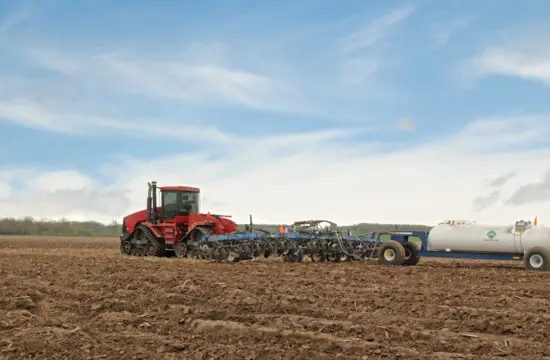As combines are slowing, it’s time to consider applying anhydrous ammonia fertilizer for the fall. Farmers who choose to apply nitrogen (N) in the fall should follow these guidelines to help reduce risk and reduce N loss.
4 Tips for Applying Anhydrous Ammonia
1. Consider the Form
John Sawyer, Iowa State University Extension soil fertility specialist, recommends only applying anhydrous ammonia. All other forms should be saved for spring-applied applications or sidedressing in Iowa. Other states may approve of banded or broadcast urea applications, but they may need to be applied at a later date.
2. Watch the Temperature
Apply in late fall after soils cool to 50°F, says Sawyer. When checking the temperature, measure at a 4-inch depth. The temperatures should be trending cooler at the time of application. A temporary cold spell is usually too early for anhydrous ammonia application, says Sawyer.
If anhydrous ammonia is applied before the temperature is 50°F., microbial activity can lead to the conversion of ammonium to nitrate. The more conversion of ammonium to nitrate, the better chance for nitrate loss, says Sawyer.
3. Protect the N
“Consider a nitrification inhibitor to further slow nitrification to nitrate,” says Sawyer. For farmers in Iowa, use of nitrogen fertilizer managers in the fall is on the approved list of practices for the voluntary nutrient reduction strategy.
4. Consider a Soil Sample
“Probably not a widespread concern this fall, but in some areas, soils may be or may become quite dry,” says Sawyer. “Dry soil means there is room for moisture storage when rainfall occurs. That is important for potential loss of nitrate as leaching will be minimal until soil field moisture capacity is reached. However, dry surface soils, and compacted soils, can sometimes be an issue for the retention of anhydrous ammonia fertilizer at application time.
“Dry soil can hold ammonia,” says Sawyer. “Even air-dried soil contains some moisture, although it’s quite low. Ammonia dissolves readily in water, but it is held or retained in soil by clay and organic matter. The problem with low soil-moisture conditions is that moisture is needed to temporarily hold the ammonia so it can become attached to clay or organic matter as ammonium. If dry soils are cloddy and do not seal properly during application, the ammonia can be lost at injection or seep through the large pores between clods after application.”
This makes the proper depth of the injection and good soil coverage a must. Traditionally, depths have been 6 to 8 inches deep.
When applying anhydrous ammonia to the soil via injection, several physical and chemical reactions take place: ammonia dissolution in water, reaction with soil organic matter and clay, and attachment of ammonium ions on the soil cation exchange complex, he says.
“These reactions all tend to limit the movement of ammonia, with water having the greatest initial effect,” says Sawyer. “The highest concentration of ammonia is at/near the point of injection, with a tapering of the concentration toward the outer edge of the retention zone.
“Usually the greatest ammonia concentration is within the first inch or two of the injection point, with the overall retention zone being up to 3 to 4 inches in radius in most soils.”
Shape and size of the ammonia retention zone can vary depending on application rate, knife spacing, soil type, and soil conditions at injection. Soil conditions can result in greater ammonia concentration toward the soil surface, which leads to a greater potential for loss.
“Movement toward the soil surface can also occur for some time after application if the soil dries and the knife track ‘opens up’ as the soil dries,” says Sawyer.
“When ammonia is injected into soil, the initial reaction at the point of release is violent,” says Sawyer. “The ammonia reacts and binds with soil constituents such as organic matter and clays. It reacts with water to form ammonium (NH4+).”
Those reactions help retain ammonia at the injection point, he says. “With the high affinity for water, soil moisture is important for limiting the movement of ammonia, but does not ultimately determine retention in soil. After conversion to ammonium, which is a positively charged ion, it is held on the soil exchange complex and does not move with water. Only after conversion to nitrate (NO3–), via the nitrification process, can it be lost from soil by leaching or denitrification.
“Be mindful of application date and soil temperature for fall anhydrous ammonia application, and what is happening at application, especially if soil conditions are not ideal,” continues Sawyer. “If the soil is breaking into clods, there isn’t good coverage of the knife track with loose soil, and ammonia is escaping, then stop and either change the way the equipment is working or is set up, or wait until the soil has better structure or moisture.”
What Can Be Done to Minimize Anhydrous Ammonia Crop Injury?
There are several techniques that can help minimize the risk of crop injury when using spring-applied anhydrous ammonia. If planting shortly after application, avoid planting directly over the injection area to ensure the seed is not in direct contact with the ammonia.
Planters equipped with GPS technology and offset positioning can also help minimize the risk of crop injury. Offsetting the planter by at least four inches from the injection opening to avoid direct contact with anhydrous ammonia can decrease the risk of crop injury and allow for planting on the same day as the application with minimal consequences.
Other beneficial techniques include applying the ammonia in one direction while planting the crop in another and adjusting the application rate and spacing of the injection knives. By carefully coordinating the application directions and lowering the application rate or narrowing the spacing between the injection knives, the potential for harm to the crop is minimized, thereby maintaining crop integrity and promoting healthy growth.
What is Anhydrous Ammonia?
Anhydrous ammonia (NH3) is a widely utilized and efficient nitrogen fertilizer source in agriculture. It is easy to apply and readily accessible to farmers, which helps contribute to crop productivity. In agricultural applications, NH3 is converted into a liquid form through compression, necessitating high pressure and specialized tanks and equipment.
However, NH3 can be hazardous if mishandled. Anhydrous ammonia lacks water content and possesses a strong affinity for moisture, which can lead to severe dehydration, caustic burns, and frostbite upon contact with skin, eyes, throat, or lungs.
Proper storage, transportation, handling, and application procedures are crucial to prevent accidents and injuries associated with NH3. The MDA implements safety measures and regulatory programs to ensure the safe use of NH3, providing protection for agricultural workers and those nearby.
Frequently Asked Questions
Anhydrous ammonia fertilizer is a type of nitrogen fertilizer that contains almost pure nitrogen in a gas form. It is commonly used in agriculture to increase crop yields.
Anhydrous ammonia is usually injected into the soil as a liquid, where it quickly transforms into a gas and mixes with the soil moisture. The nitrogen in anhydrous ammonia fertilizer is then absorbed by plant roots to support growth.
Anhydrous ammonia fertilizer is a cost-effective and efficient way to supply crops with nitrogen, which is essential for plant growth. It can also help increase crop yields and improve soil health.
Anhydrous ammonia is a hazardous substance that can be dangerous if not handled properly. It is extremely corrosive and can cause severe burns if it comes into contact with skin or eyes. It is also toxic when inhaled and can cause respiratory problems.
Anhydrous ammonia should be stored in a cool, dry, and well-ventilated area. It should be kept away from heat sources, such as direct sunlight or hot equipment, and should never be stored near flammable substances.
If there is an accidental release of anhydrous ammonia fertilizer, immediately evacuate the area and contact emergency services. Anhydrous ammonia can be hazardous to human health and the environment, so it is essential to follow proper safety procedures in case of a release.
Anhydrous ammonia is typically suitable for most crops, but the amount and timing of application may vary depending on the crop and soil conditions. It is best to consult with a knowledgeable agronomist to determine the best fertilizer plan for your specific needs.

